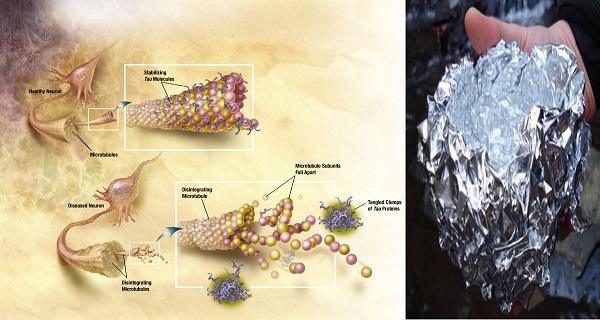Breast cancer awareness groups have long been warning about the risks of aluminum exposure through contaminated anti-antiperspirants (1).
Aluminum is a neutotoxin that’s also been linked to dementia, autism, Alzeimer’s and Parkinson’s disease.
Its free ion, Al(3+) (aq), is highly biologically reactive and uniquely equipped to do damage to essential cellular (neuronal) biochemistry.
With more work going into the autopsies of Alzheimer’s patients, it’s becoming undeniable that aluminum is directly linked to the disease.
Aluminum & Your Brain
Alzheimer’s is the most common type of dementia, a neurological disease that causes problems with memory, thinking and behavior .
The link between Alzheimer’s and aluminum was first discovered in 1965, when researchers discovered that injecting rabbits’ brains with aluminum caused them to develop neurofibrillary tangles, the same twisted proteins found in brain cells of patients with Alzheimer’s disease .
By 1980, Daniel Perl and Arnold Brody had managed to actually peer inside human brain cells and found aluminum too.
“It became very, very difficult to get funding to work on aluminum. As soon as you mentioned aluminum, you’re dismissed with ‘Oh, that hypothesis was disproven years ago,’” explains John Savory, a professor emeritus of pathology at the University of Virginia.
“But it has not been disproven. The truth is, nobody knows.”
Aluminum Passes Through The Blood-Brain Barrier
Once in your body, aluminum travels around easily, by hitchhiking on your iron transport system. Biological barriers that normally keep other types of toxins out can’t detect it, even your blood-brain barrier. This is why aluminum is particularly detrimental to mental health.
Professor Chrisopher Exley of Keele University discovered the first direct link between aluminum exposure and the disease.
The case study examined a 66-year-old Caucasian man who died of Alzheimer’s disease and showed significantly elevated brain aluminium content, 2.98 (2.73) μg/g dry weight, n = 46, following occupational exposure to aluminium over a period of 8 years.
“The presence of aluminium in the human brain should be a red flag alerting us all to the potential dangers of the aluminium age,” he warns.
“There are neither cures nor effective treatments for Alzheimer’s disease. The role of aluminium in Alzheimer’s disease can be prevented by reducing human exposure to aluminium and by removing aluminium from the body by non-invasive means. Why are we choosing to miss out on this opportunity?”
And if that doesn’t convince you, researchers who conducted another study on the subjects warned:
“Misconceptions about Al (aluminum) bioavailability may have misled scientists regarding the significance of Al in the pathogenesis of AD (Alzheimer’s disease). The hypothesis that Al significantly contributes to AD is built upon very solid experimental evidence and should not be dismissed. Immediate steps should be taken to lessen human exposure to Al, which may be the single most aggravating and avoidable factor related to AD.”
Other Health Effects Of Aluminum
Alluminum affects the musculoskeletal and respiratory systems(11). It can also accumulate in the bone, brain, liver, heart, spleen and kidneys (12).
Most aluminum is flushed out of the body by the kidneys.
However, it’s quite difficult for your kidneys to filter out and some traces of aluminum end up accumulating through the body and within the kidneys themselves. Over time, this can lead to kidney failure .
Aluminium exposure is also linked to airway inflammation and asthma.
And that’s just the proven dangers of the element. There are many other diseases linked to aluminum, including fibromyalgia, that are still awaiting scientific confirmation.
How To Avoid Aluminum
Aluminum in its non-metallic form is found everywhere. It’s one of the most abundant elements in the earth, so it occurs naturally in the foods we eat.
It’s also naturally found in drinking water and some municipalities purposefully add it to drinking water in the water treatment process .
According to CDC, the average adult in the US consumes about seven to nine mg of aluminum per day in food, and a lesser amount from air and water. Only about 1% of this aluminum stay in your body, the rest is expelled through your digestive system .
The mineral can be found in anything from flour and baking mixes to soup, chocolate, beer and wine, and herbal teas. It’s also commonly found in cosmetics, antiperspirants (even crystal salts), toothpaste and drugs.
Unexpected sources of aluminum include baby formula and antacids.
In fact, a study published in the journal Environmental Sciences Europe analyzed 1,431 non-animal foods and beverages for aluminum content.
This is what they found:
- 77.8 % had an aluminum concentration of up to 10 mg/kg
- 17.5 % had aluminum concentrations between 10 and 100 mg\kg
- 4.6 % of the samples had aluminum concentrations in excess of 100 mg/kg
Aluminum is often used as an additive in powdered and liquid processed foods. Contamination can also occur from using aluminum cookware and aluminum foil, especially when cooking meat.
To avoid aluminum exposure, carefully read labels and avoid canned foods and goods packaged in aluminum-line boxed or containers (such as fruit juice). It’s also a good idea to avoid baked goods that aren’t cooked in glassware.
If you fear that you may be overloaded with aluminum, grab a carrot.
The American Journal of Clinical Nutrition reported that carrot juice can pull these heavy metals from fatty tissue where they reside, bind them up, and discharge them from the system.
You can also detox your kidneys to help them better expel the element from your body.
